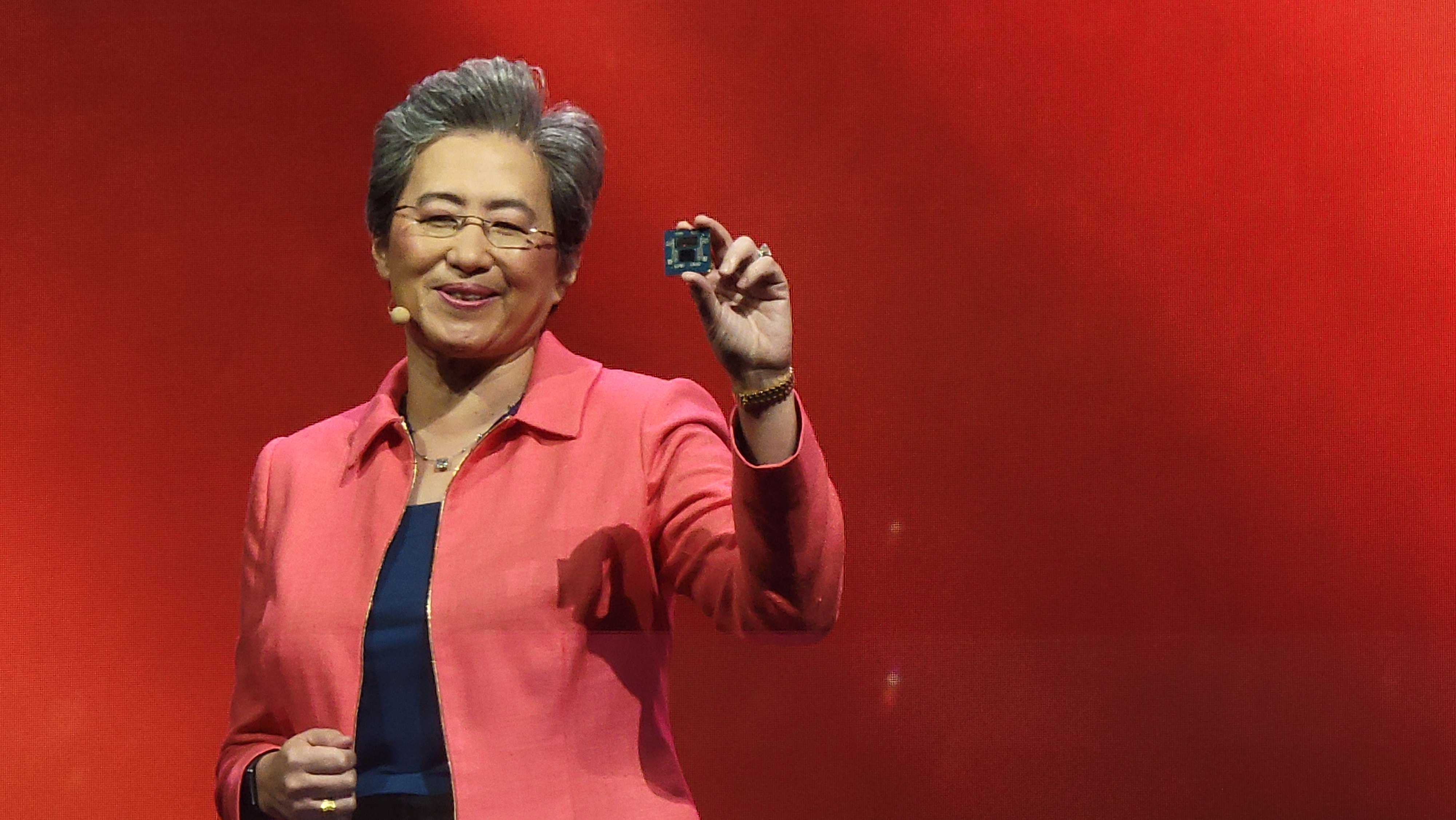
AMD ripped the covers off four new 4nm Zen 5-powered Ryzen 9000 processors in the Ryzen 9, 7, and 5 families today at Computex 2024 in Taipei, Taiwan, touting that the new Zen 5 architecture will deliver a 16% increase in instructions per cycle (IPC) throughput when the chips come to market in July. Coupled with other improvements, AMD claims the new flagship Ryzen 9 9950X outperforms Intel’s competing Raptor Lake Refresh flagship by an average of 11% in gaming and 21% in productivity workloads, but these will eventually face off with Intel’s Arrow Lake. The chips also feature doubled performance in AI and AVX-512 workloads.
The new Zen 5 chips span from the 6-core 12-thread Ryen 5 9600X to the 16-core 32-thread Ryzen 9 9950X and come with the same core counts as their predecessors, but most models also come with a lower TDP (30% to 40% reduction) while still delivering higher performance than the prior-gen models due to the revamped Zen 5 architecture and a new TSMC 4nm process node. The new Zen 5 chips drop into the AM5 socket, which AMD now says it will support until 2027+, and the company unveiled new X870/X870E chipsets that increase USB 4.0 connectivity and extend PCIe 5.0 support to both chipsets.
AMD also updated its venerable AM4 platform with two new Ryzen 5000XT models that keep it alive seven long years after its release. The flagship Ryzen 9 5900XT model has four more cores than its predecessor, ostensibly for the same price. These chips are designed to bring higher performance to the AM4 platform using the Zen 3 architecture to offset the value proposition of Intel’s previous-gen chips, which can often be found at a stiff discount.
On that note, AMD hasn’t yet divulged pricing, but we do know plenty of other new details. Let’s dive into specs, benchmarks, and the Zen 5 architectural details.
AMD Zen 5 Ryzen 9000 ‘Granite Ridge’ Pricing and Specifications
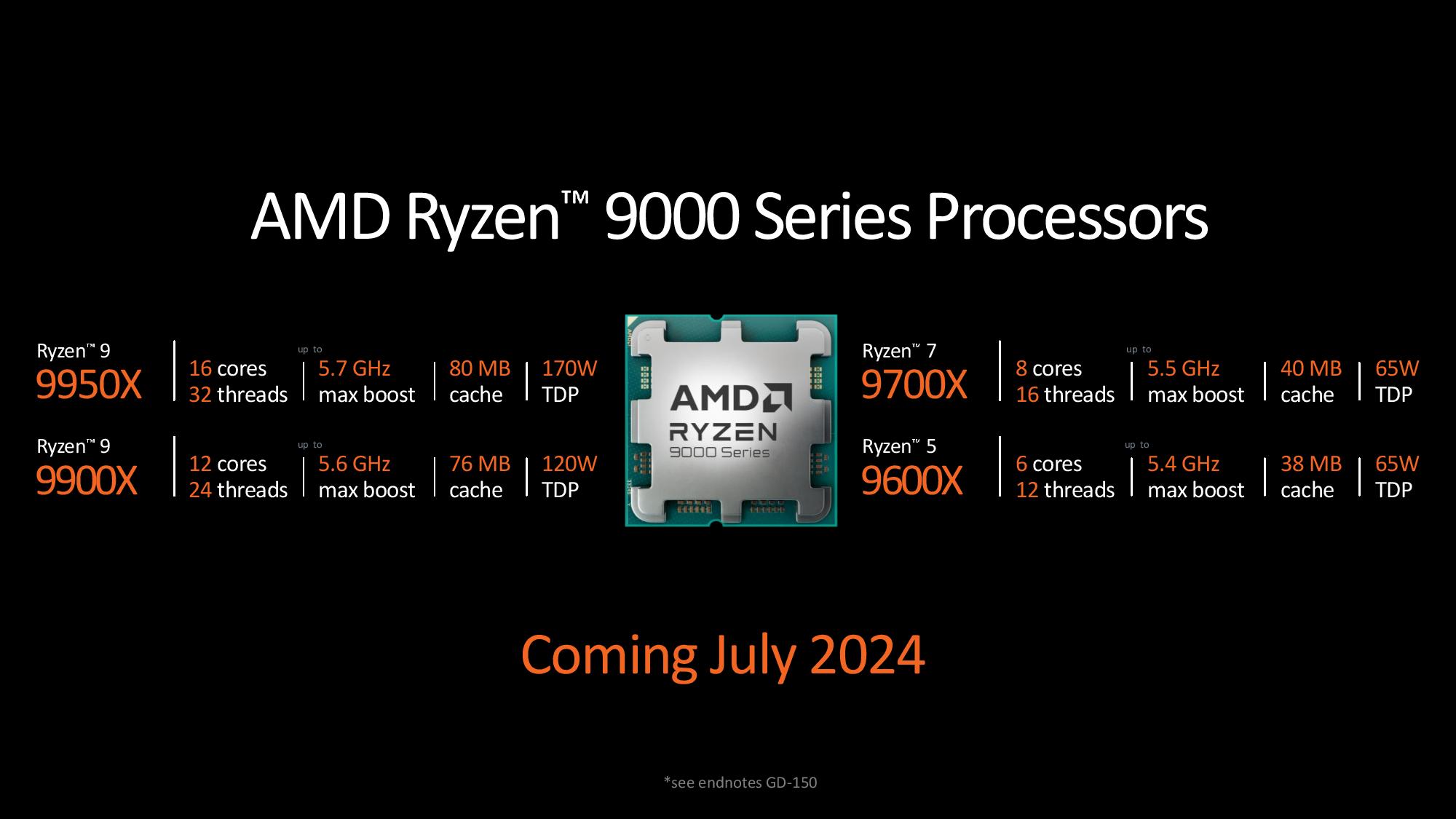
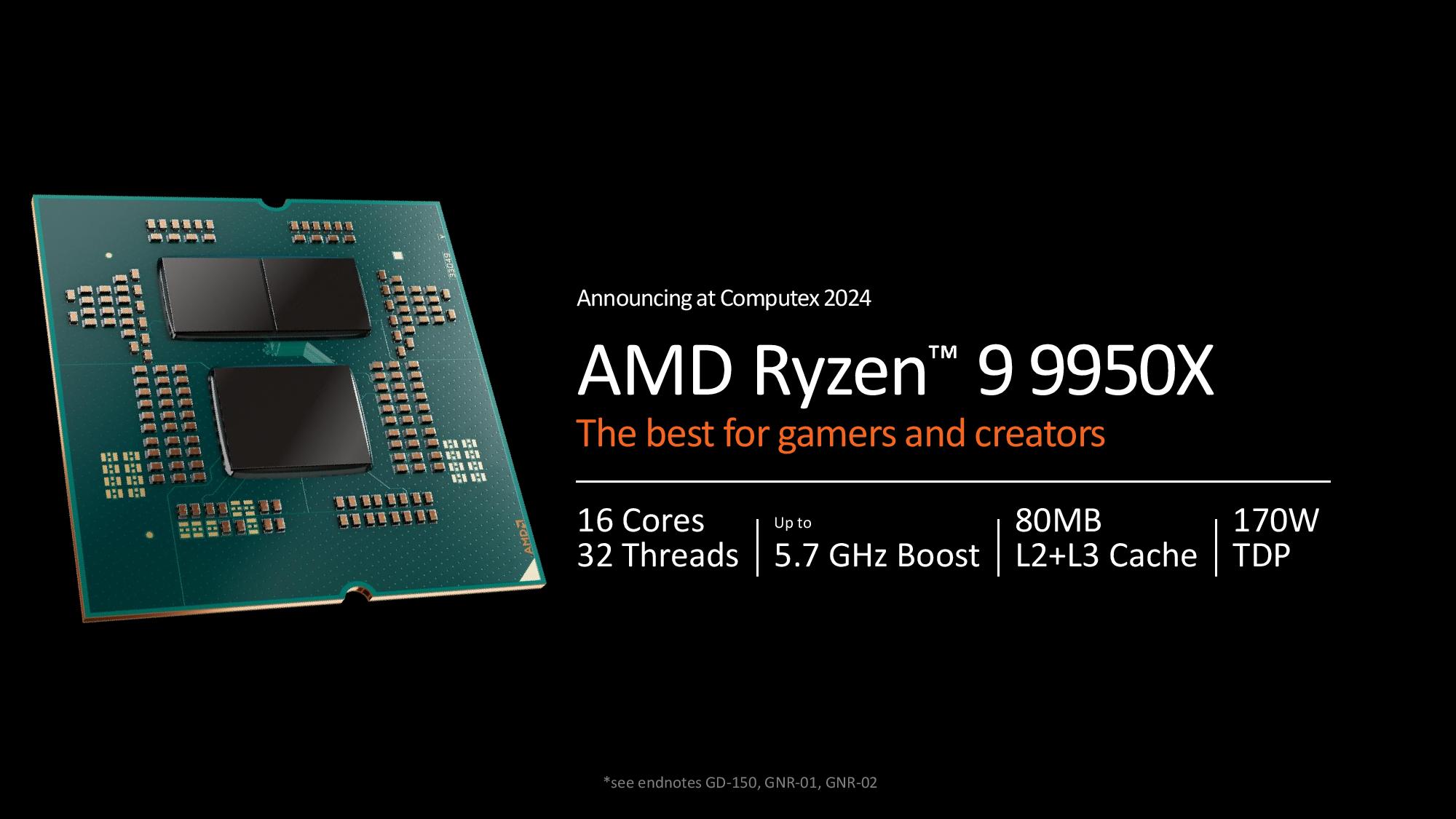
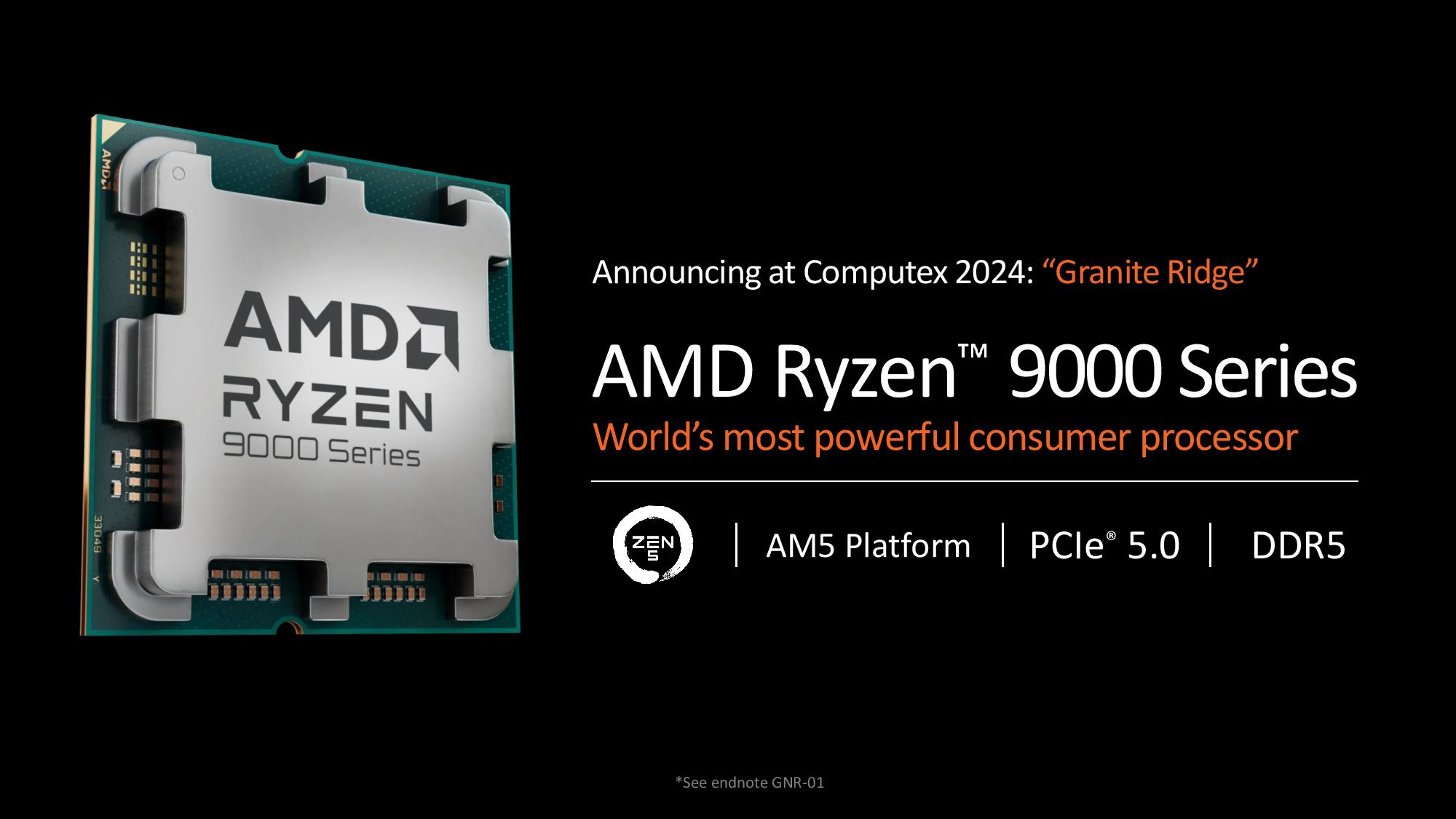
We’ll cover what we know about the Zen 5 architecture below, but the 16% gain in IPC and a move to a newer node imparts significant performance improvements despite the same core count, frequencies, and cache capacities as the prior-gen Ryzen 7000 models. Three models have significant gen-on-gen TDP reductions, and AMD cites a doubled cache data bandwidth among the improvements that significantly boost gaming performance. That means we shouldn’t take the similar gen-on-gen specs as a sign of stagnation — AMD says the Zen 5 Ryzen 9000 lineup delivers significantly more performance, often at much lower power consumption, than the Zen 4 predecessors.
As such, pay attention to the game and application benchmarks below to gauge the relative improvements. AMD claims substantial gaming performance improvements for its Ryzen 9000 series, but it’s aimed at general workloads. Notably, AMD doesn’t claim that Ryzen 9000 are the fastest gaming chips in the world. That implies the gaming-optimized Ryzen 7000X3D lineup will continue dominating the top of the gaming charts, at least until the 3D V-Cache-equipped Ryzen 9000X3D models arrive. There’s still plenty to learn, though, as we still don’t know some of Ryzen 9000’s finer-grained details. AMD has increased the base memory speeds to DDR5-5600.
The new Ryzen 9 9950X replaces the 7950X, but aside from the newer CPU microarchitecture, it has the same basic accommodations, like 16 cores, 32 threads, a 5.7 GHz peak frequency, 80MB of combined L2+L3 cache, and a 170W/230W TDP/max rating. AMD dialed back the base clock by 200 MHz. This chip will initially compete with Intel’s $548 Core i9-14900K, but Intel’s as-yet-unannounced Arrow Lake processors will be the real competitors for Ryzen 9000.
We begin to see differences in the lesser Ryzen 9, 7, and 5 families. Aside from the massive 50W TDP decrease to 120W, most of the Ryzen 9 9900X’s specs match the previous-gen model. The 30% TDP reduction represents a tremendous improvement in power efficiency, especially given that AMD also claims substantial gen-on-gen performance improvements. However, AMD lowered the base clocks by 300 MHz. AMD says users can continue using the auto-overclocking Precision Boost Overdrive (PBO) feature to unlock higher performance by uncorking the power limits. For now, this chip lines up against Intel’s $389 Core i7-14700K.
The Zen 5 Ryzen 9 9700X gets a 100 MHz bump to a 5.5 GHz boost while most other specs remain the same. However, the lower TDP rating of 65W is a 40W reduction compared to the prior-gen Ryzen 9 7700X despite the similar core counts. Base clocks have been reduced by 700 MHz, which obviously helps to rein in the TDP. This chip will face off with Intel’s $380 Core i7-14700K.
Likewise, the Ryzen 5 9600X gets a 100 MHz increase to a 5.4 GHz boost and a reduction to a 65W TDP, another substantial 40W decrease, making this look like an exceptional counter to Intel’s Core i5-14600K that currently retails for $305. Again, AMD dialed back the base clock by a whopping 800 MHz to help reduce the TDP rating.
AMD Zen 5 Ryzen 9000 ‘Granite Ridge’ Gaming and Productivity Benchmarks
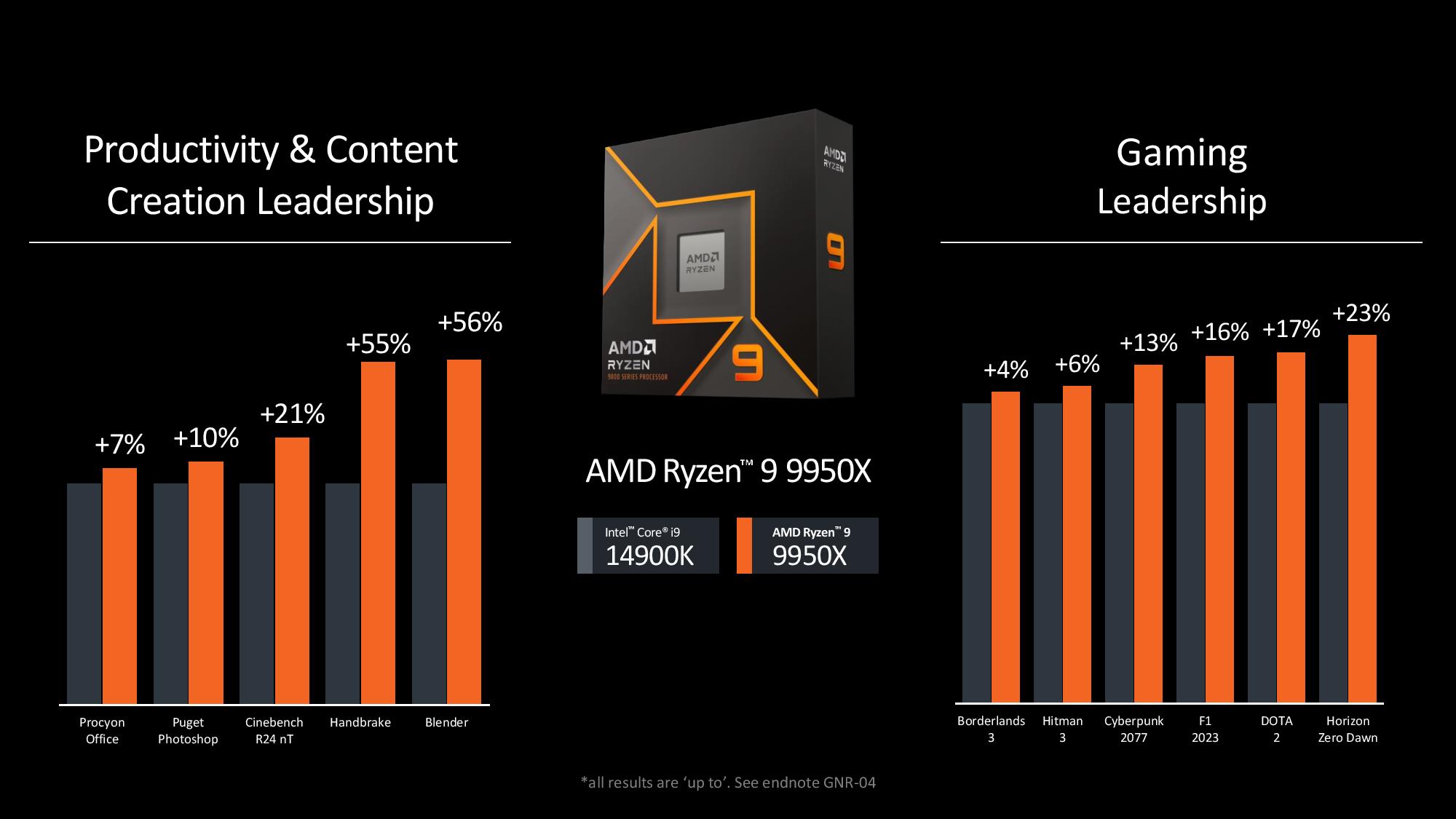
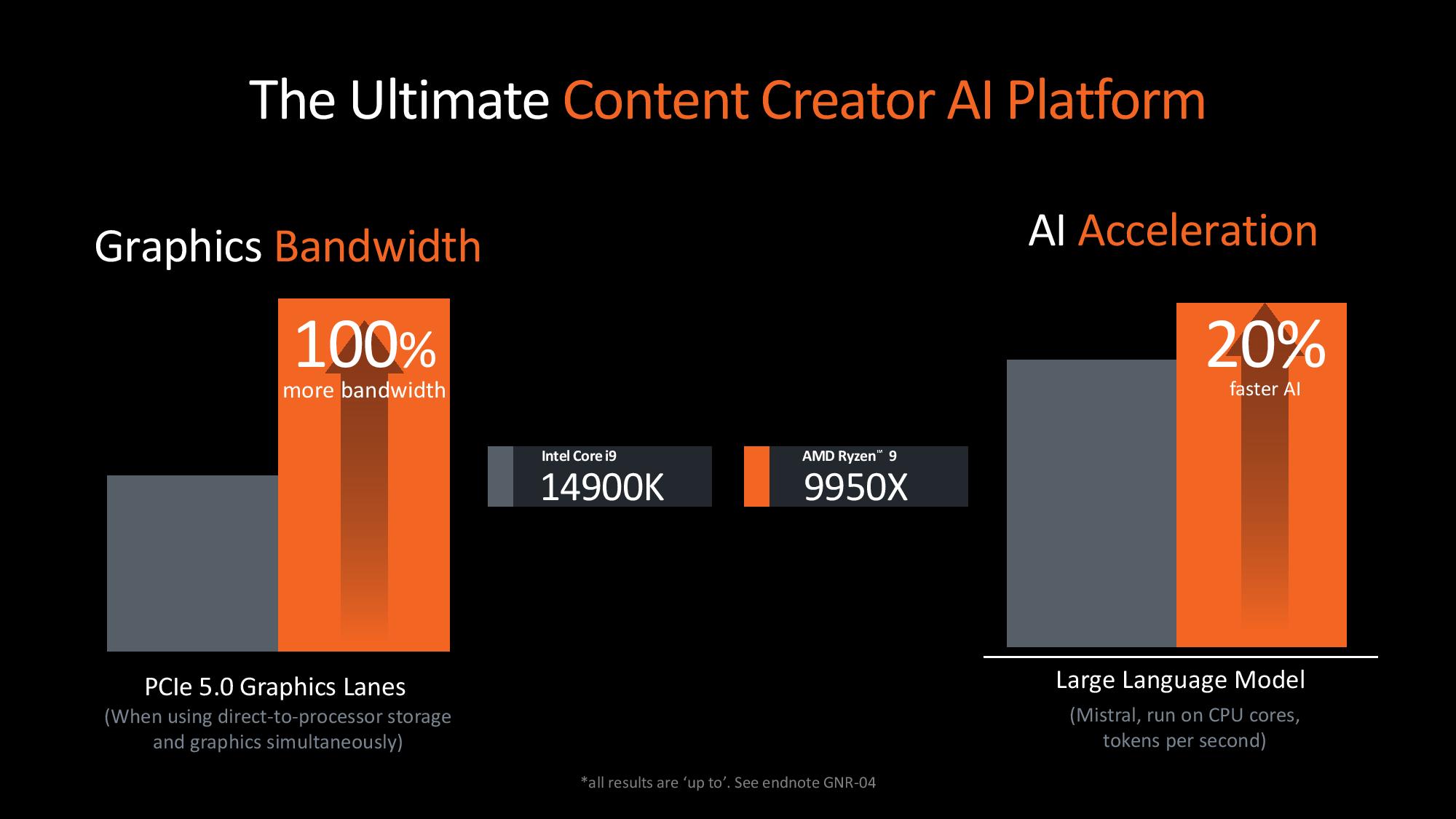
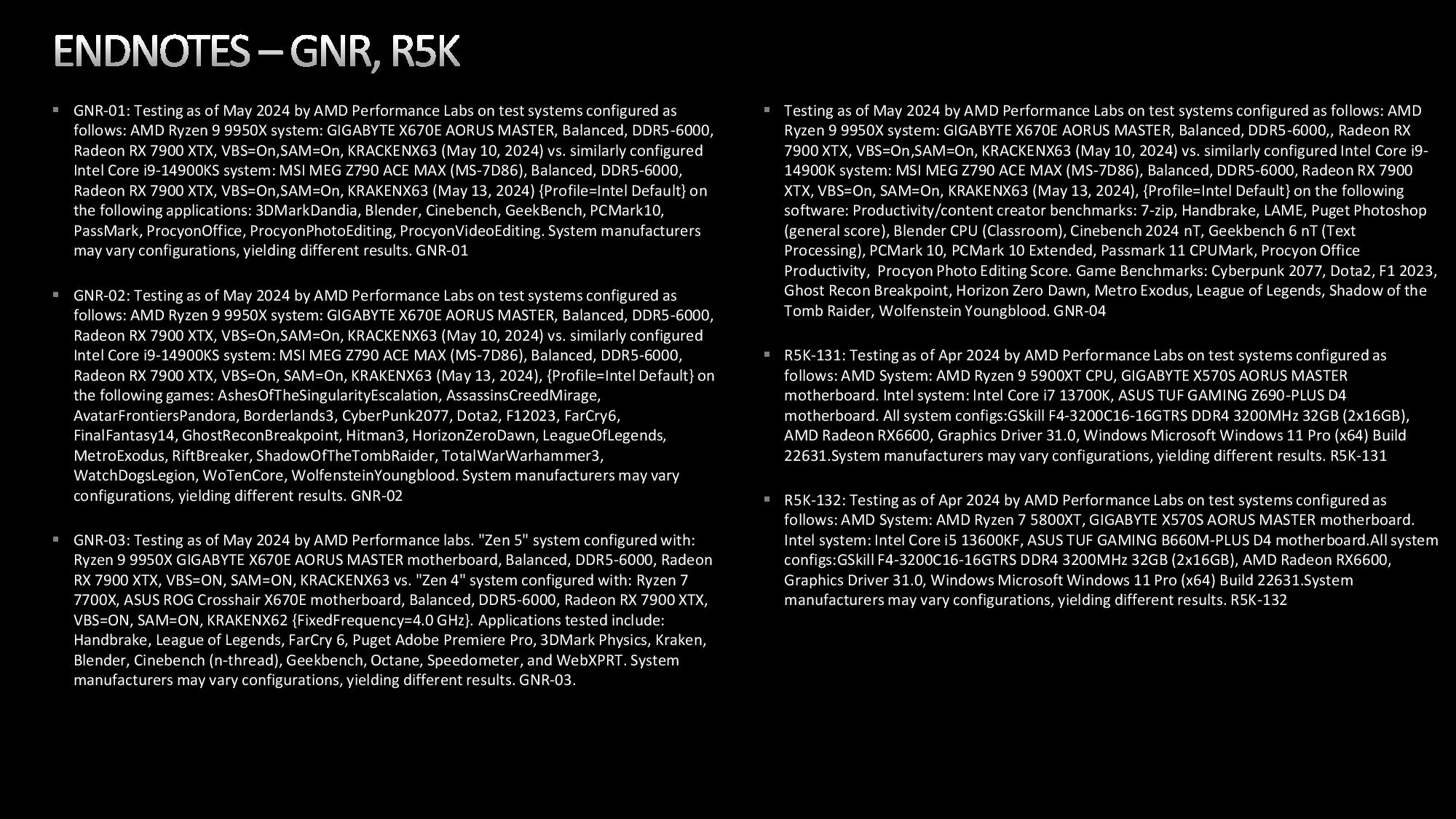
As with all vendor-provided benchmarks, take these AMD-provided benchmarks with a grain of salt (we’ve included the test notes at the end of the album). AMD says the Ryzen 9 9950X is considerably faster than the Core i9-14900K in a range of both productivity workloads (7% to 56%) and gaming workloads (4% to 23%). This works out to a geomean of a substantial 21% gain in productivity and an 11% gain in gaming. Naturally, we’ll need to wait for reviews to see a larger outlay of tests. In either case, it does appear that AMD has taken the edge over Intel’s Raptor Lake Refresh, but we don’t know how these chips will stack up against Intel’s true competitor, Arrow Lake.
AMD says the Ryzen 9 9950X is 20% faster in AI workloads than the Core i9-14900K and that it offers 100% more PCIe 5.0 throughput when both a direct-to-CPU PCIe 5.0 SSD and PCIe 5.0 GPU are used. Yes, that’s a bit of an odd claim – there aren’t any PCIe 5.0 GPUs on the market yet, but AMD says they are coming ‘soon.’ Regardless, this would still only be relevant in a very limited subset of content creation applications that use GPU acceleration, or multi-GPU AI setups.
AMD Zen 5 IPC and Architectural Changes
AMD says that Zen 5 represents a complete overhaul of the architecture, yielding a 16% increase in IPC, but it’s best to start at the process node it will etch its design onto. AMD hasn’t shared the details of the node it uses, but the TSMC 4nm process node replaces the previous-gen’s N5 node. Assuming Ryzen 9000 uses TSMC’s N4P node, the most likely candidate, TSMC claims 11% more performance, 22% higher power efficiency, and 6% higher transistor density (optical shrink) over the N5 node.
Additionally, TSMC says this process uses 6% fewer masks for production due to an increased number of EUV layers, implying that it’s more cost-effective. TSMC also says that N4P is technically part of its 5nm family of process nodes, so the design rules are compatible, speeding deployment for users already on the N5 node.
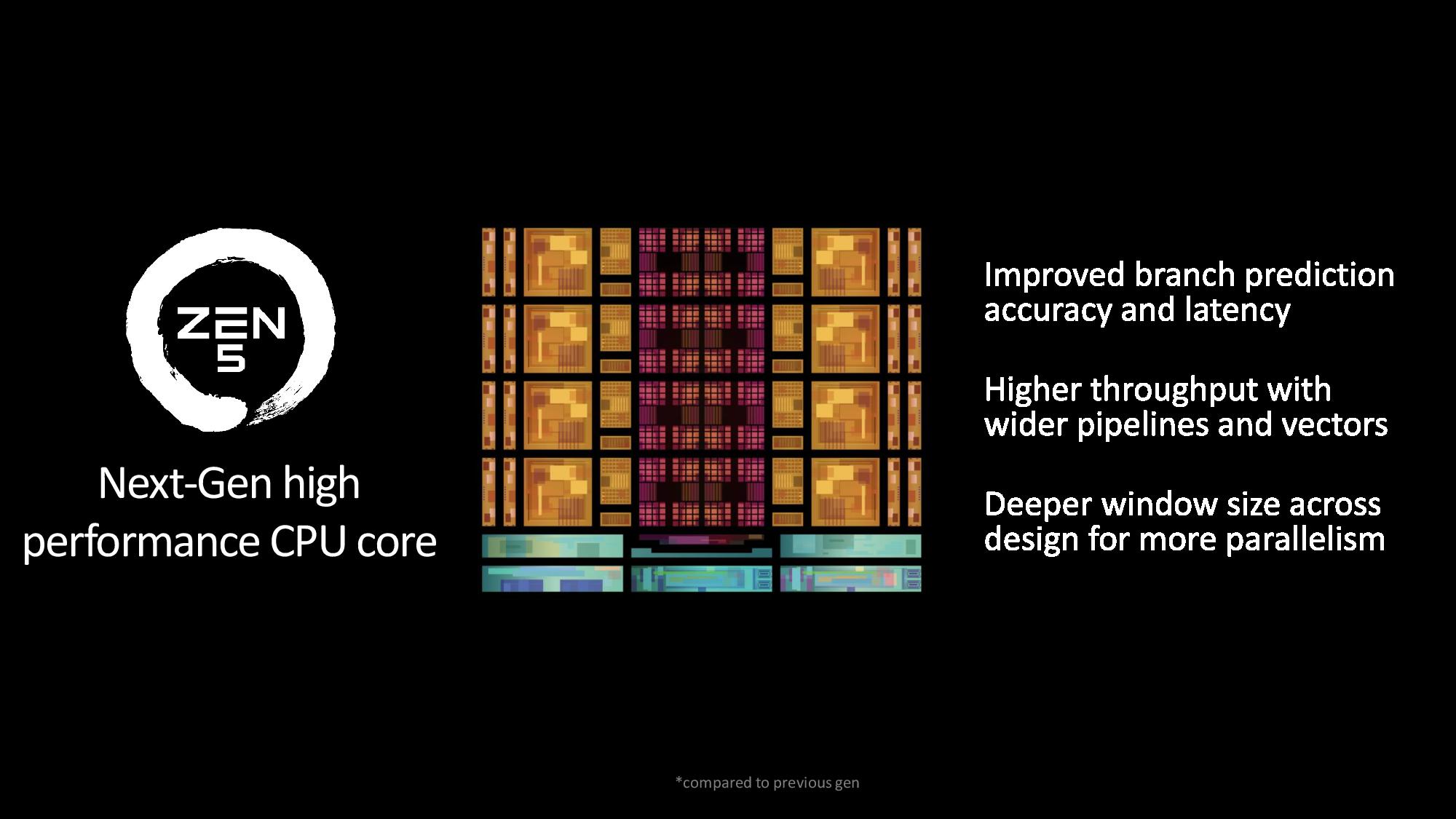
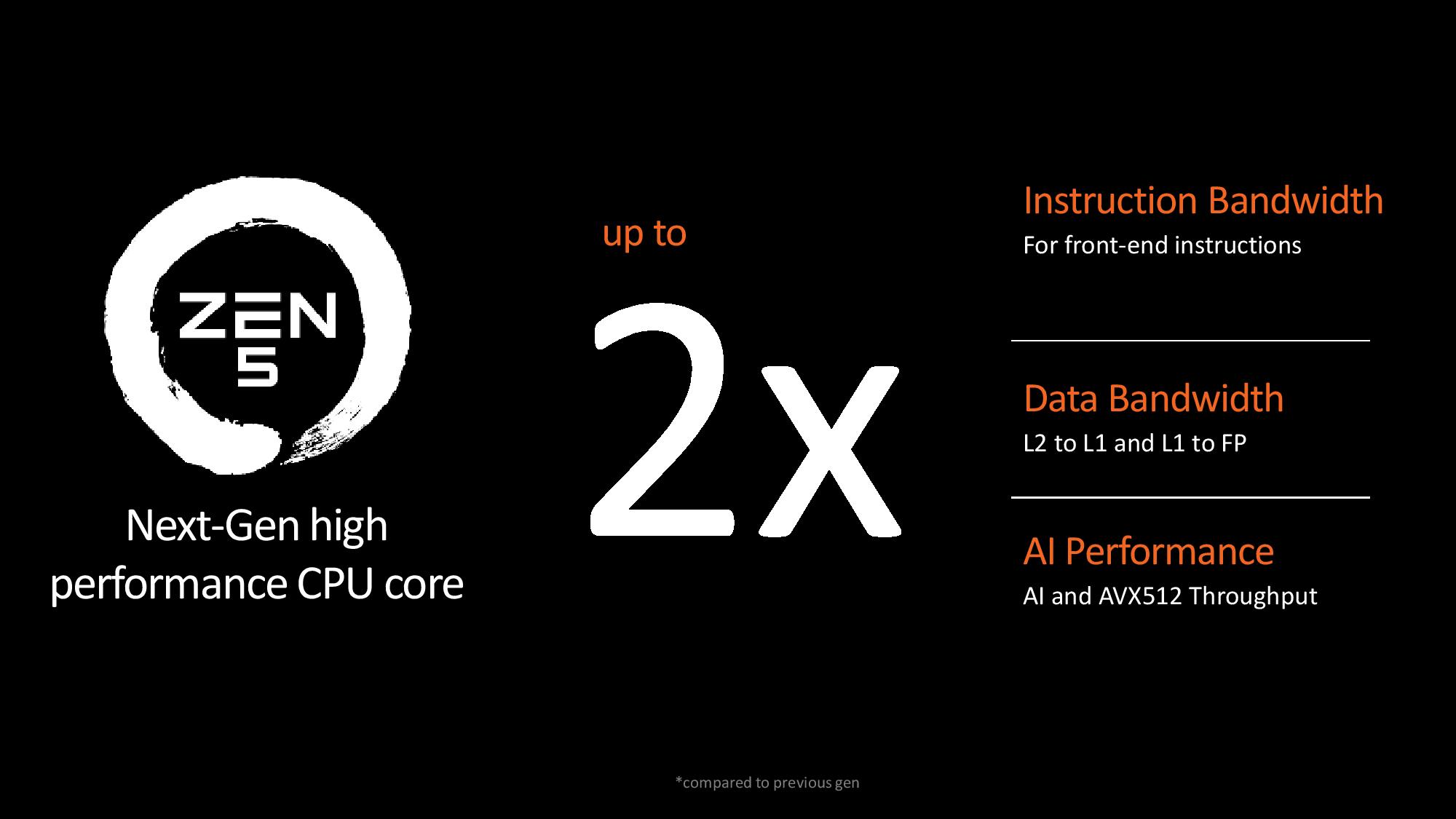
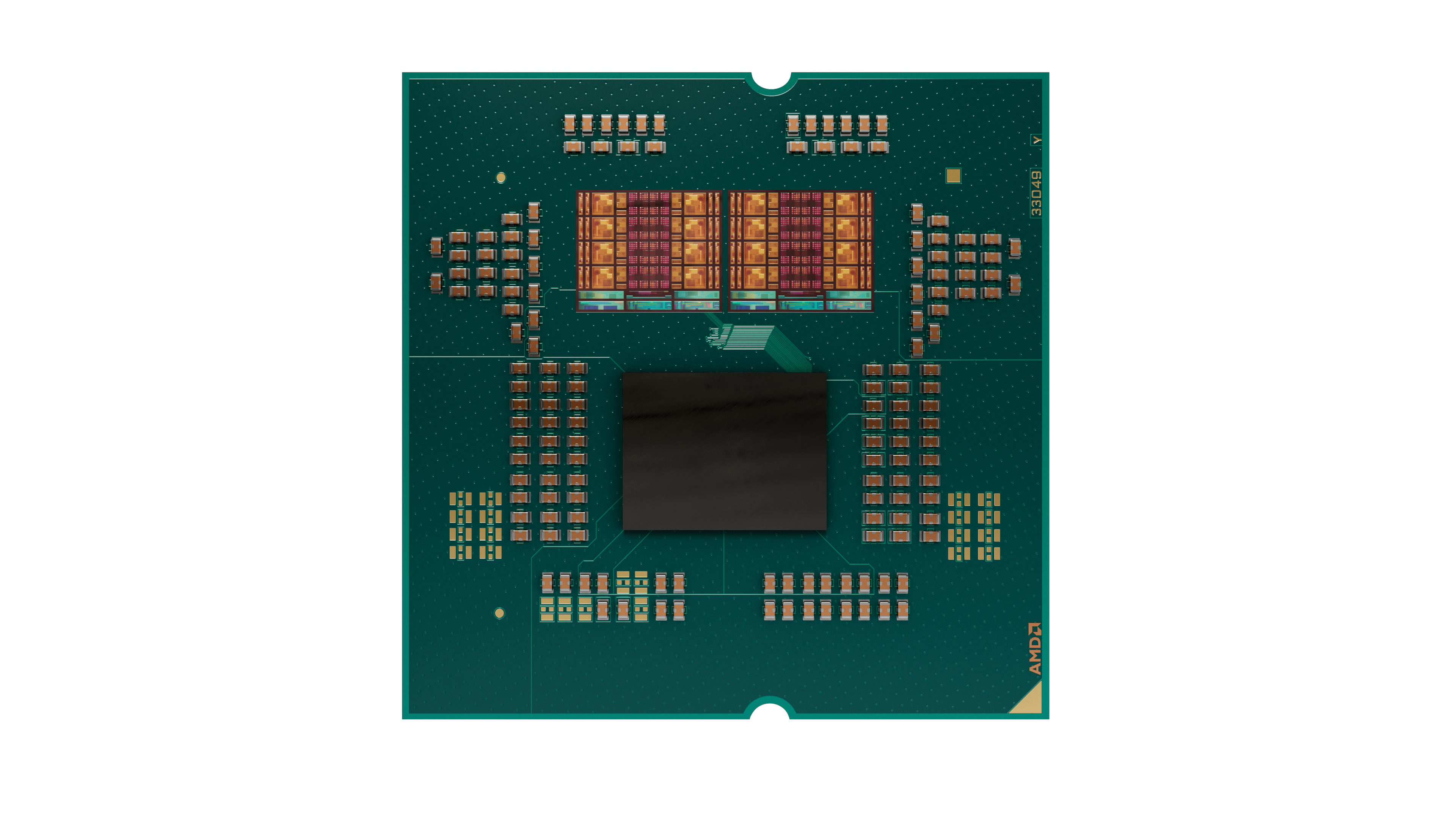
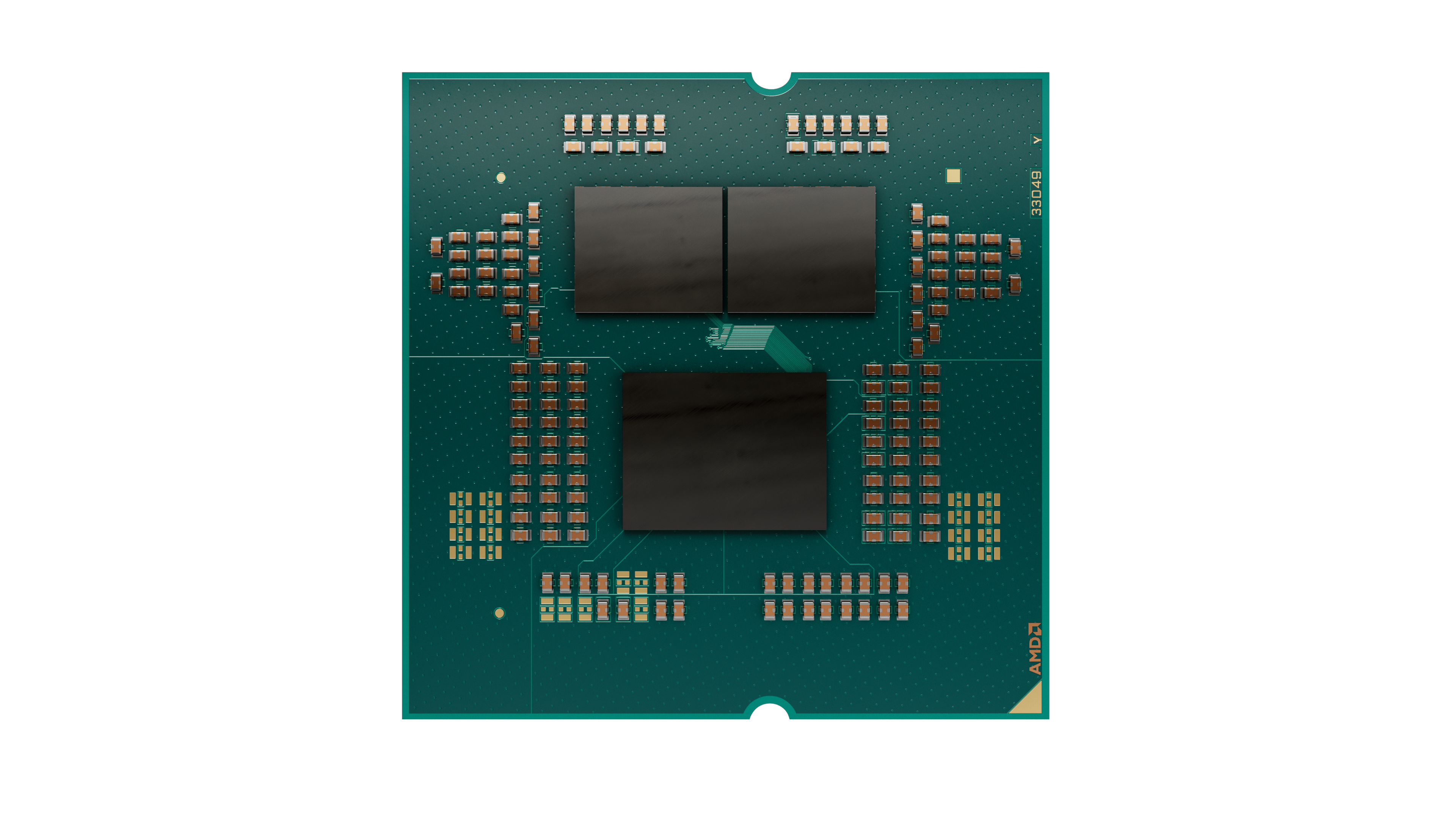
AMD only shared the broad strokes of the Zen 5 architecture, but the block diagram indicates that it is built on the same core compute die (CCD) architecture with a maximum of eight cores and a large central 32MB shared L3 complex, just as with the prior generation. As expected, the chips come with the same basic physical design and use the same 6nm I/O Die (IOD), so we can expect the same graphics support and basic connectivity options. The company says the frequency residency (how long the chip stays in boost) is enhanced with Zen 5 chips due to the efficiency of the integrated heat spreader (IHS) design, implying some improvements to the thermal design.
The core microarchitecture has seen several enhancements; AMD points to its doubled data bandwidth between its L2 and L1 caches and the L1 to floating point unit as a contributor to its gen-on-gen gains in gaming performance. That makes sense, as latency tremendously impacts gaming performance.
Other improvements include improved branch prediction accuracy and latency that will help avoid pipeline bubbles and stalls. Zen 5 also features doubled instruction bandwidth for front-end instructions, a nice pairing with the improved branch prediction (this also suggests a wider retire queue, but AMD hasn’t shared that level of detail yet).
AMD also cites higher throughput with wider pipelines and vectors, a call out to its support for AVX-512 that may indicate it no longer uses a dual-issue AVX-512 pipeline, wherein it simply issues an AVX-256 instruction twice to provide most of the performance benefits of AVX-512 while avoiding the impact to die area. It’s possible that AMD now has a full AVX-512 pipeline, which seems rational given that it cites doubled AVX-512 and VNNI (AI instruction) throughput. The architecture also features a deeper window size across the entire design for increased parallelism.
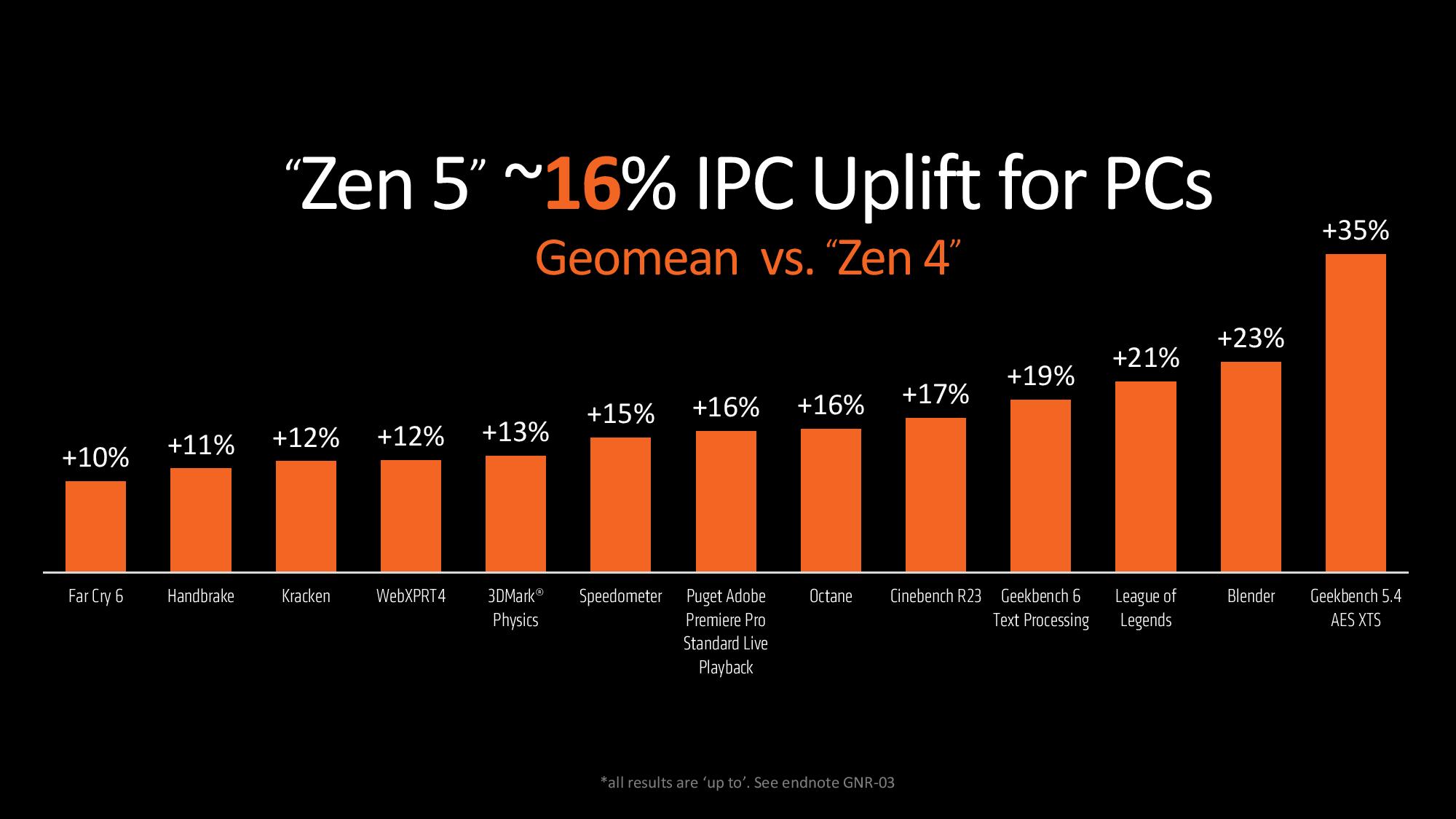
AMD has steadily improved Zen’s IPC since its debut back in 2017 with a whopping 52% improvement over Bulldozer. Zen 5 represents the fifth consecutive double-digit IPC increase as AMD steps forward with a 16% improvement, outpacing the 13% jump from Zen 3 to Zen 4.
AMD measures its IPC improvement using the geometric mean of 13 workloads, and it's noteworthy that this also includes games—a type of workload that AMD didn’t use to specify its IPC gains with the first few iterations of Zen (it would be interesting to see these numbers when tested with the same subtests).
AMD claims a 10% to 35% gain across these tests, but there is a notable 35% outlier in the final Geekbench 5.4 AES XTS test, likely a byproduct of the improved AVX-512 throughput and crypto-specific instructions. However, AMD uses a geomean to smooth out the impacts of outliers on its calculations, so removing this test only reduces the overall score by a single percentage point.
AMD X870/X870E Chipsets
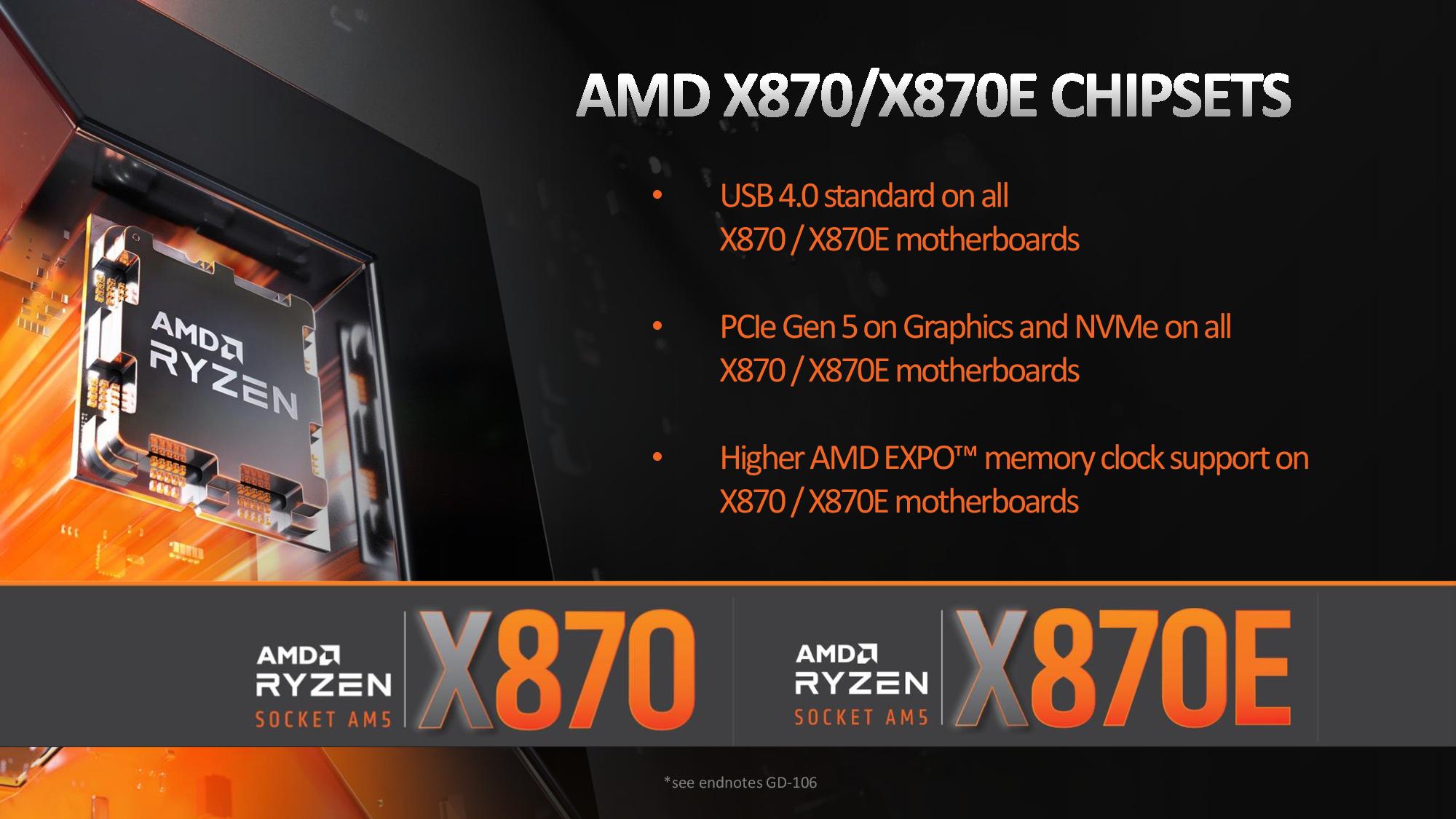
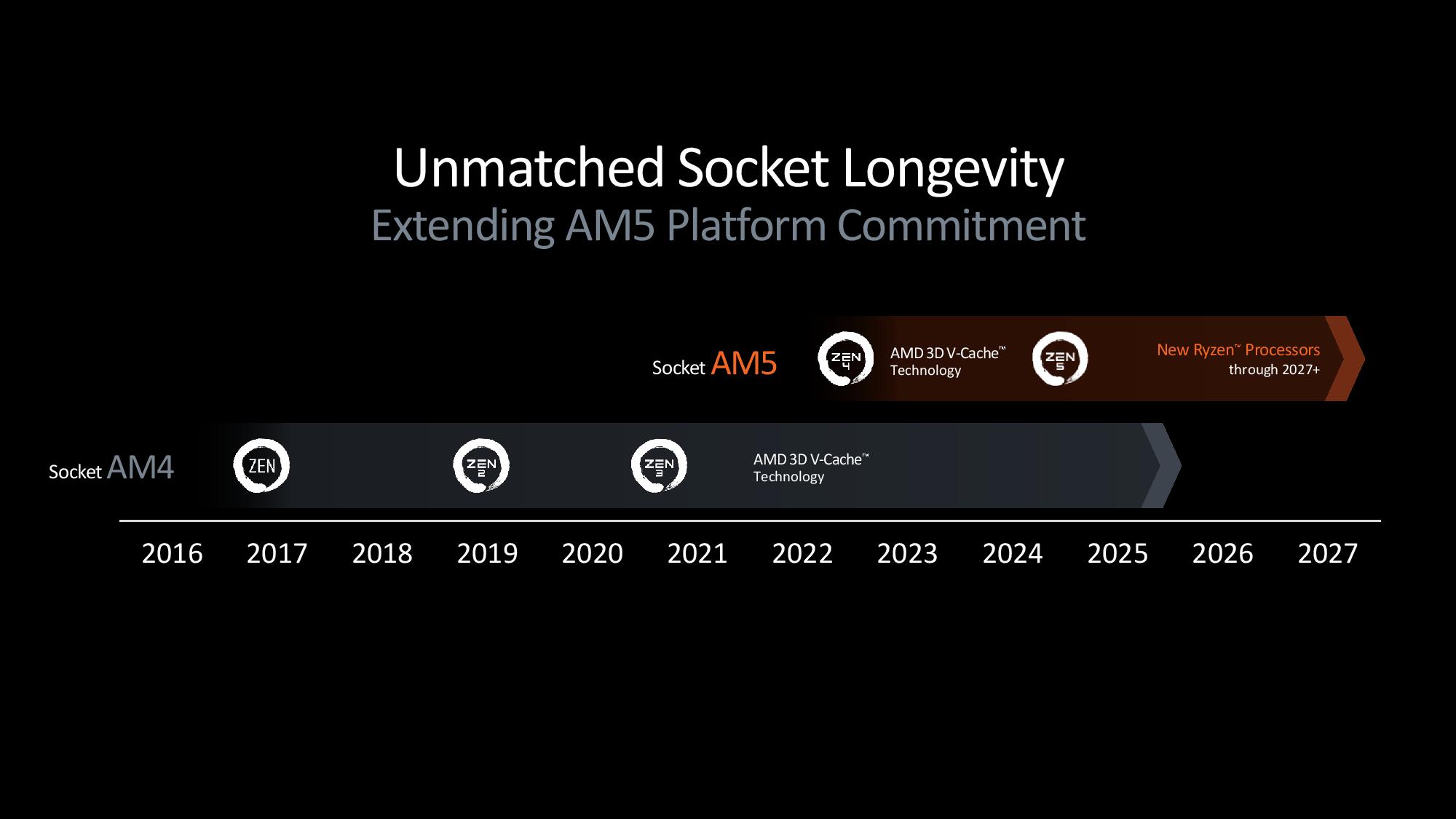
AMD’s AM4 platform has lived on for seven years, and it’s still going as AMD has also released new AM4 models, which we’ll cover below. The AM5 platform is well on its way to joining the AM4ever club, as AMD has extended its original commitment of support from 2025+ to a new window that extends to 2027+. That’s a win for those investing in a desktop PC now, as they can upgrade to at least two new generations of processors in the future (and X3D variants, too).
AMD is also introducing its new X870 and X870 chipsets with the new lineup of chips, but it hasn’t introduced refreshed lower-end B- and A-series boards (we expect those to be released later). The Ryzen 9000 series is backward compatible with existing AM5 boards, but AMD says the new AM5 motherboards now support higher EXPO memory overclocks (notably, the benchmark tests notes say AMD tested with DDR5-6000 for its benchmarks, but the company commonly uses overclocked memory to represent stock performance). Details are still a bit scarce, but we do know that AMD is now extending support for PCIe 5.0 to the X870 lineup for both storage and graphics, whereas that was previously limited to the E-series boards.
AMD also says that all boards will now come with the USB 4 60 Gbps interface, but all indications are that the support isn’t built into the chip itself. Rather, USB 4.0 comes courtesy of third-party controllers, like the ASMedia ASM4242, meaning the controller will consume some of the PCIe lanes from the CPU to operate at full bandwidth.
AMD Ryzen 5000XT Processors for AM4 platform
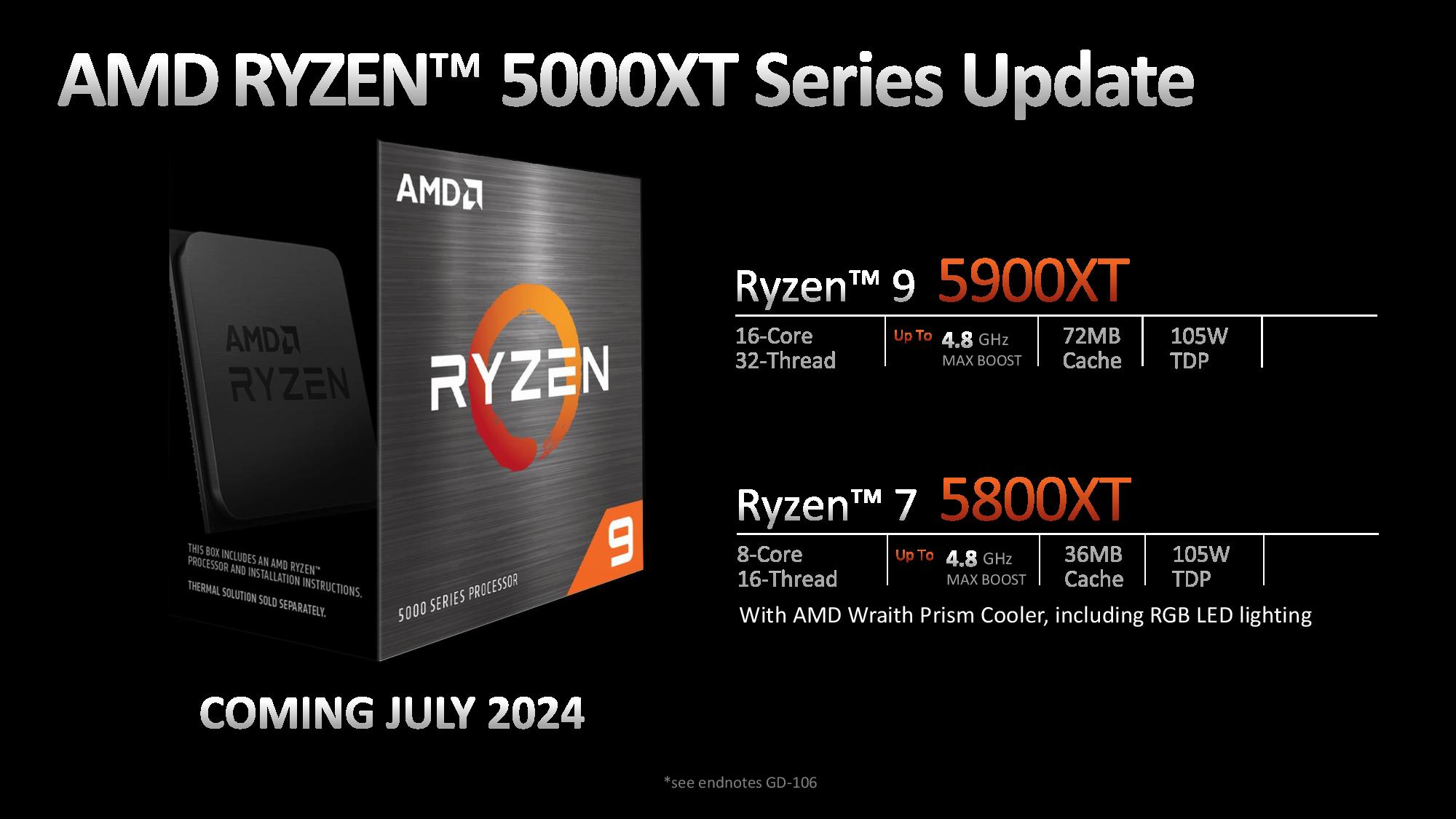
AMD is also keeping the low-cost alternative AM4 platform alive and kicking in 2024 to fend off the competitive price pressure from Intel’s previous-gen Raptor Lake processors. The AM4 platform has now supported 145 CPU and APU models to date. Additionally, AMD says the platform still sees robust sales in areas like China and Latin America, where DDR4 pricing is lower and AM4 motherboards are more affordable than AM5 boards. It isn’t restricting the chips to certain regions, though; they’ll be available worldwide.
This is the second generation of Ryzen XT chips, and while the lower-tier model offers slim generational performance gains like the older XT models did, the top-tier 5900XT offers four more cores at a lower price point. The two new Ryzen 5000XT AM4 chips come with the Zen 3 architecture and, ostensibly, the tried-and-true TSMC 7nm node.
The Ryzen 9 5900XT is the more interesting of the two chips, with its 16 cores and 32 threads being a significant upgrade over the previous-gen 12-core Ryzen 9 5900X. The 5900XT matches the core count of the higher tier Ryzen 9 5950X and has the same boost of 4.8 GHz, 105W TDP, and 72MB of L2+L3 cache. As such, the performance should be nearly identical to the 5950X. For all intents and purposes, this appears to be AMD offering the Ryzen 9 5950X at a steep discount for AM4 users to fend off the Core i7-13700K.
AMD also offers the Ryzen 7 5800XT, which has the same eight cores and 16 threads as its predecessor, the Ryzen 7 5800X. However, it gains 100 MHz to the peak boost clock rate, bringing it to 4.8 GHz. All other specs remain the same, but AMD now includes a bundled Wraith Prism cooler to sweeten the deal.
AMD Ryzen 5000XT Benchmarks
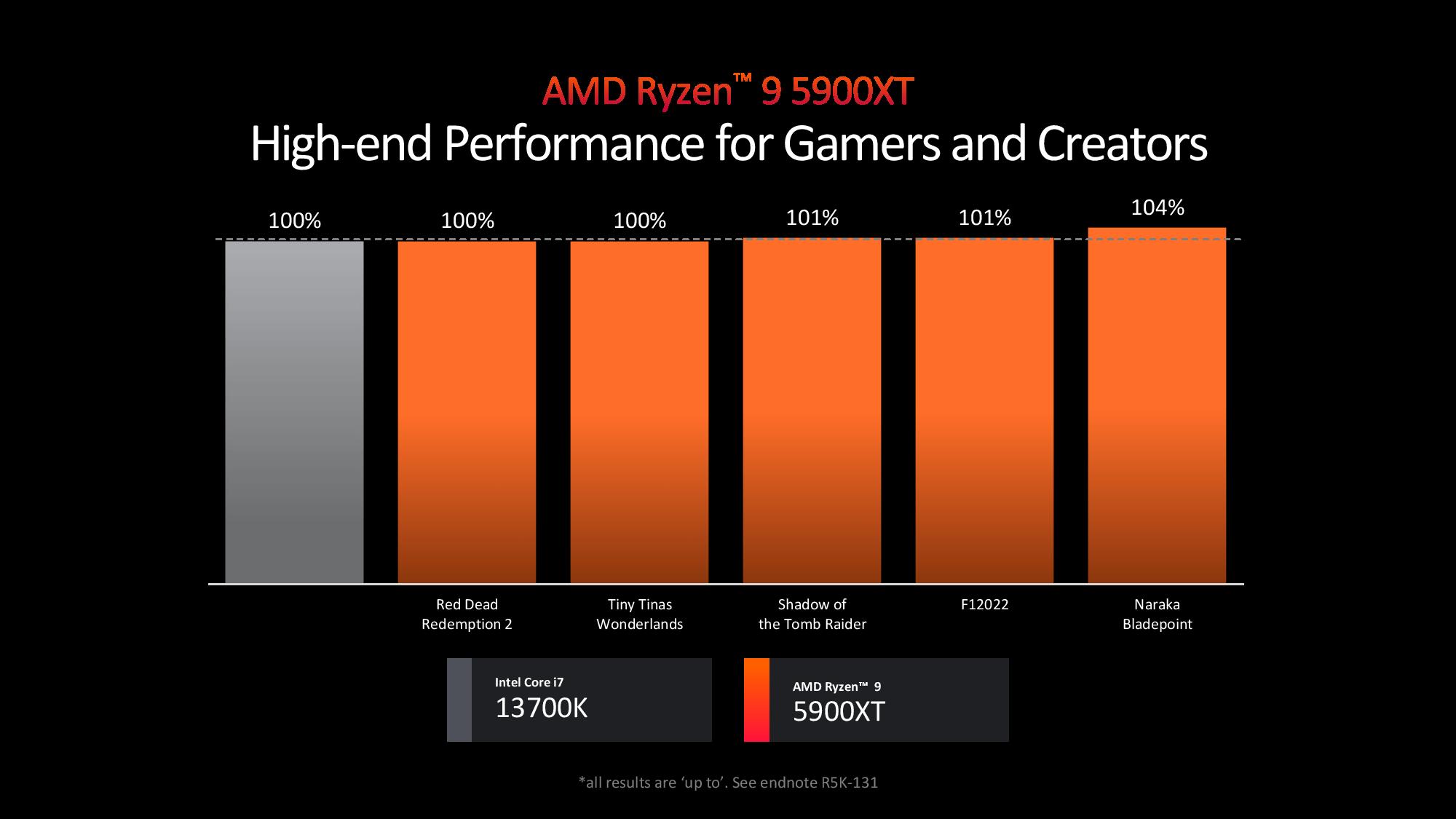
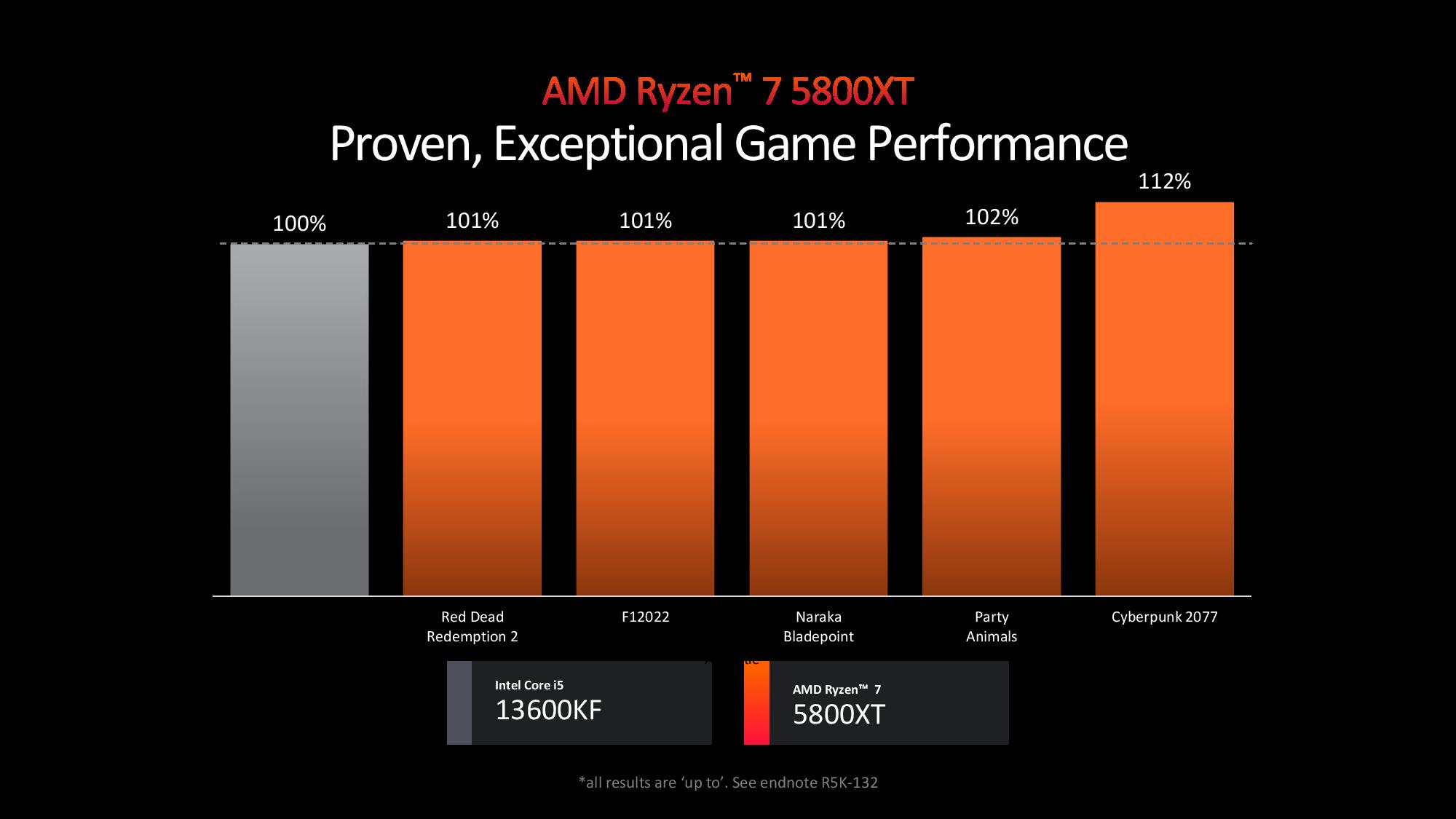
AMD provided a few benchmarks against Intel’s chips, with all of the chips kitted out with DDR4 to highlight performance for value-focused builds. The Ryzen 9 5900XT matches or slightly exceeds the Core i7-13700K in an odd selection of game titles, while the 5800XT trades blows with the Core i5-13600KF in a different selection of games, again either matching or slightly exceeding Intel’s prior-gen chip. These benchmarks aren’t exceptionally impressive, but they do drive home that AMD offers comparable performance to Intel’s value options.
Thoughts
AMD’s Ryzen 9000 series aims to bring the goodness of a revamped Zen 5 architecture paired to counter not only Intel’s existing Raptor Lake Refresh chips, but also the as-yet-unannounced Arrow Lake processors. Ryzen 9000 looks well positioned to take on Intel’s coming chips, with the 16% IPC increase floating all boats in terms of performance, while the up to 40% reduction in TDP for the lower-tier models capitalizes on AMD’s power consumption advantages.
Naturally, Arrow Lake will come with plenty of innovation, with Intel’s new 20A process node, which will feature its first backside power delivery (PowerVia) and gate-all-around (GAA—RibbonFET) transistors. Both of these will mark a significant multi-node advance over Intel’s current Raptor Lake Refresh chips. The chips are also said to come with the new Lion Cove P-cores and Gracemont E-cores, again marking another significant step forward.
All of this is to say that we expect an exceptionally competitive desktop PC market as we move into the latter half of the year. AMD will fire the first shots with its Zen 5-powered Ryzen 9000 and the new Ryzen 5000XT models when they arrive in July 2024.



!["[T]he First and Fifth Amendments Require ICE to Provide Information About the Whereabouts of a Detained Person"](https://images.inkl.com/s3/publisher/cover/212/reason-cover.png?w=600)



